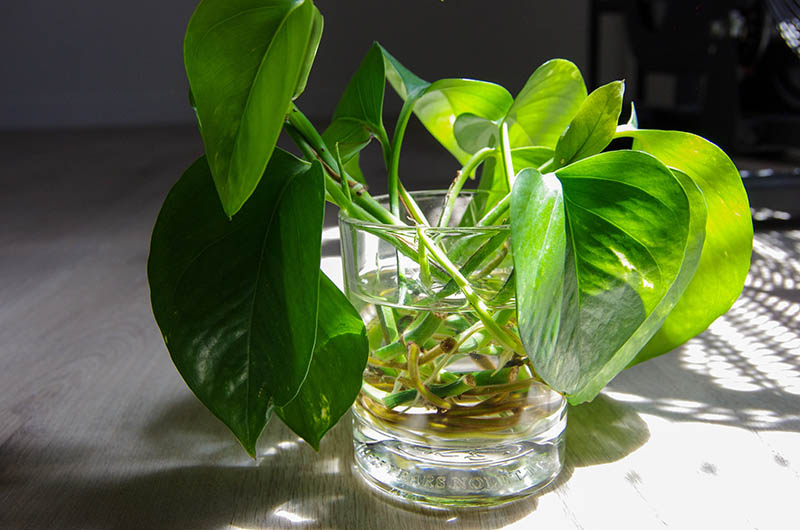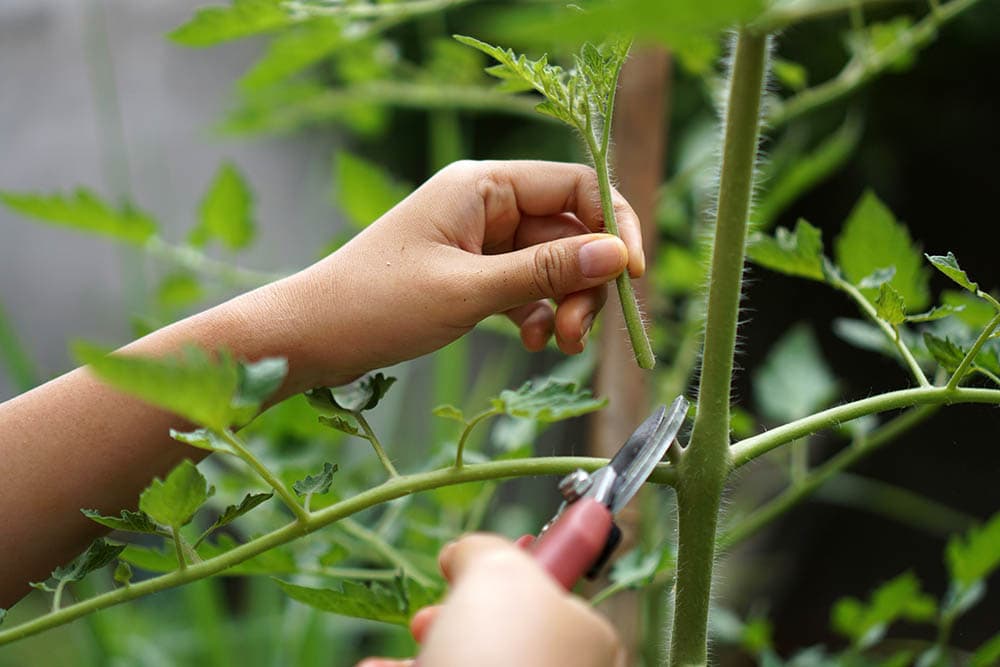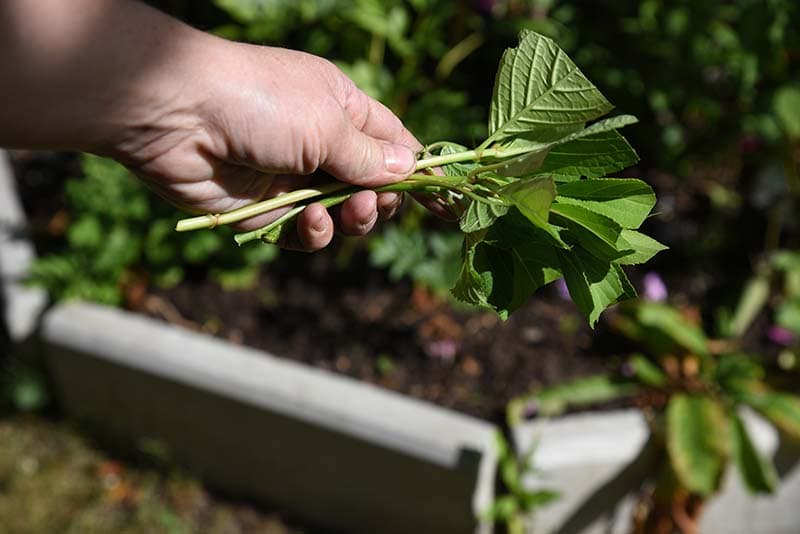How to Root Plant Cuttings in Water (4 Expert Propagation Tips)
-

- Last updated:

Propagating plant cuttings in water is common practice, as most plant cuttings root faster in water than in soil. To do this, take cuttings from an established plant or herb and place the cuttings in the water and watch it sprout roots in a few weeks.
This is an easy and inexpensive way of expanding your garden and collection of house plants. Read on to master these gardening tips with help from experts.
Topics that are covered in this article:
What Is the Fastest Way to Root Plant Cuttings in Water?
Rooting plant cuttings in water is one of the easiest ways of growing new plants. When done right, rooting cuttings in water can save you a lot of unnecessary expenses and time.
- Identify a healthy plant and mark where you’ll get the cutting. Although not all plant cuttings need a node to root in water, most do, so it’s vital to include it.
- Carefully cut ¼ inches below the mark using a sharp, clean knife or a pair of scissors.
- Place the cutting on a clean surface and inspect the cutting you’ve made. It should be a clean cut with no jagged edges.
- Get a clean container—clear is best—and pour in enough clean water and add the cutting. Ensure the node is submerged.
- Refill the container with fresh water after every 4 days.
- Rooting can take weeks or months, depending on the type of plant. Once the roots reach around 3–5 inches, it’s time to plant the cutting in soil.

The 4 Tips That Can Help Your Cuttings Thrive
Plant cuttings require adequate care to thrive. Some of the tips you can use include the following:
1. Use Clean, Sharp Tools
The tools you use to make the cutting should be sharp and clean. This ensures that the cut heals faster, less dirt gets into the cut, and the knife’s edge does not cut the plant tissue in the stem. Clean tools transfer fewer diseases from one plant to another and give your cutting a high chance of rooting right from the start.
2. Ensure the Environmental Conditions Are Met
To successfully propagate a plant cutting in water, ensure you provide the proper environmental conditions. This includes placing the container in a warm and humid environment with enough natural light. Doing so prevents water loss from transpiration, especially if you are working with a leaf cutting or a softwood plant. You should also place the container in a place with enough air circulation; this helps stop diseases from spreading and prevent rotting.

3. Clean the Container
The container you are using to propagate the cutting should be properly washed beforehand. This helps in preventing any fungus and bacteria from attacking the cutting and spreading diseases. It also eliminates the need for fungicides and insecticides during this period.
4. Add Nutrients to the Water to Promote Root Growth
Even if you know how to root a plant cutting in water properly, it still needs the required nutrients to grow. You can increase your chances of success by using rooting powders. There are many commercial products available in the market, and you can also make your own at home. This is essential if you are rooting your cutting in distilled or filtered water.
The rooting powders also kill any fungus and bacteria that can destroy the plant by causing rotting. They also have special hormones that accelerate the growth of roots. The combination to us will depend on the type of plant and stage of rooting.
When using commercial rooting powders, sprinkle a small amount of the powder on the bottom part of the cutting and let it sit for a couple of minutes before dipping it into the water. This way, the powder will not be washed off by the water.
Why Is My Cutting Not Rooting in Water?
Are your cuttings not rooting in water, and you cannot figure out why? If it’s been 1 or 2 weeks, you simply need to be patient; some plant cuttings take longer than that for the roots to start growing. However, if several weeks have passed and there’s no sign of roots, you’ve probably done something wrong or neglected the plant cuttings.
Some of the reasons why it’s not rooting include the following:

1. The Cuttings Are Too Long
If you make your cuttings too long, they may take longer to thrive. This is because the only water available for the long cutting is from the small root tip in the water. Chances are if the cutting is too long, the leaves have already wilted. You can deal with this by reducing the cutting to about 4–6 inches.
2. You’re Keeping the Cutting Away From Sunlight
New plant cuttings need enough sunlight to thrive. If you keep them in a very dark area, they will take longer to root or die altogether. Keep them close to a window or near grow lights.
3. The Water Is Too Cold
For the roots to grow, they need warmth from the sun, so if you are keeping your cuttings too cold, then this will hinder their growth. For best results, ensure you keep the temperature at 20 degrees Celsius. You can do this by placing the jar in a sunroom or near a window where it can receive direct sunlight.
4. Not Including a Node
A node is the part where the leaf meets the vine. If you intend to use a leaf cutting for propagation, you must include it. The node is where the new roots and vines are formed, and neglecting to include it in the cutting means it has a very low chance of rooting.
5. The Cuttings Are From Old/ Unhealthy Vines
When making a plant cutting, always ensure you get one from a healthy mature plant. Avoid any plants that look old or with a pale yellow color. The plant you make a cutting from should have green leaves and a healthy upright stem.
6. You Are Not Changing the Water Often
Roots need air to flourish. You must ensure you change the water in the container every 2–3 days and replace it with fresh water. Tap water has dissolved oxygen and other gases that get depleted as the roots grow. Changing the water also keeps the cuttings clean and prevents them from getting root rot.
Conclusion
Before propagating cuttings in water, it’s best to do a bit of research on which plants this technique will work on. The best plant cuttings to use this technique on are those with a short growing season. Rooting them in water speeds up the growing process compared to sticking them in soil. Some of these plants include basil, tomatoes, pothos, ivy, waffle plants, and African violets.
Featured Image Credit: JulieK2, Shutterstock
Contents

